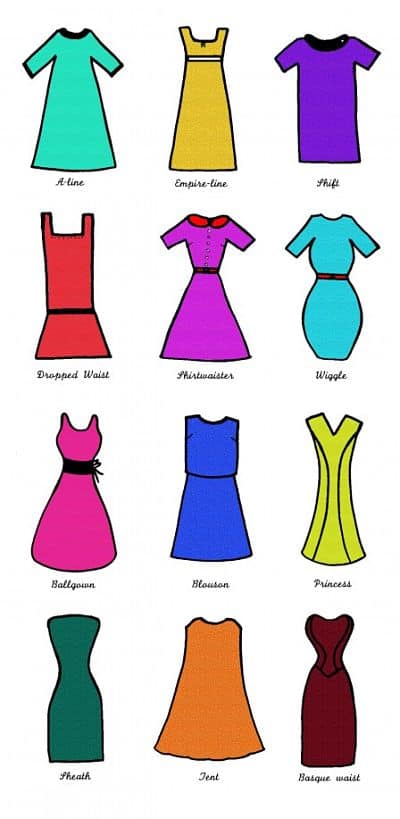Blog
All about vintage and classic dress shapes
With a lot of fashion designers cleverly mixing and combining traditional shapes and forms, you can be forgiven for not knowing a classic ‘A-Line’ dress from an ‘Empire-Line’ dress. Thankfully, when it comes to vintage dress shapes, there are some principal designs that are easy to spot that never really go out of fashion. Here are some simple drawings that illustrate the differences between some of our most popular vintage dress shapes.
 Vintage dress shapes and cuts
Vintage dress shapes and cuts
A-line: Popular in the seventies, with or without sleeves, this is narrow at the top and widest at the hem. It has a shape like a capital A!
Empire-line: This dress shape originates from the late 18th century but was most recently revived in the seventies. It has a fitted bodice which ends just below the bust. Often these are long/maxi length.
Shift: Originally worn in the roaring twenties, then epitomised in the sixties by British model Twiggy. She is very famous for wearing this style, in fact most photos show her in a Shift dress, and her thin frame certainly helped! Shift dresses are cut straight up and down with no waist definition.
Dropped waist: A popular style for the flappers of the twenties, then re-introduced in the eighties, this cut has a waist seam which is dropped to hip height.
Shirtwaister: Most often seen in the fifties, these are buttoned to the waist (like a shirt) with a full, pleated or a-line skirt and usually have a zip at the side.
Wiggle: The most famous dress worn by Marylin Monroe in the fifties. This dress is close-fitting from top to bottom and usually ends below the knee so that when you walk, you wiggle!
Ballgown: Possibly the most well-known dress shape – reminiscent of a dress Cinderella would wear – and definitely not the most practical. This shape is reserved for special occasions! Usually beautifully weighty with a net beneath, these are fitted at the bust and waist and then flow to the floor with a sweeping under-shape.
Blouson: Fairly popular in the sixties, this was also very fashionable in the eighties. A Blouson has a fitted waist which causes the material on top to ‘blouse’ or overlap the bottom half.
Princess: A pleasant variation on the A-line shape, seen in many seventies dresses, but made popular most recently in the nineties. It consists of panels, fitted at the bodice, with the A-shape starting at the waist and flaring out to the hem. Longer examples of this shape are typically used in wedding dresses.
Sheath: Popular for the majority of the later part of the 20th Century, this shape is form fitting around the bust, waist and hips. The bottom is cut straight, making it different to the wiggle dress.
Tent: Prominent in the sixties with its similarity to the baby-doll style, this loose fitting shape which widens out from the shoulders was also used in recent designs on the catwalk. If cut correctly, this shape has a lovely swing!
Basque waist: Always popular among the gothic community and re-enacters, this originally French term was particularly celebrated in dress from the Victorian era. The closely fitted bodice, often tied with string or ribbon at the back, sits over the hips, accentuating the waist – and often the bust.
When it comes to vintage dresses, there are so many exciting and unusual shapes and styles to discover. Which ones suit you? Come to our shop in Camden and find out!
Happy vintage dress hunting! x


